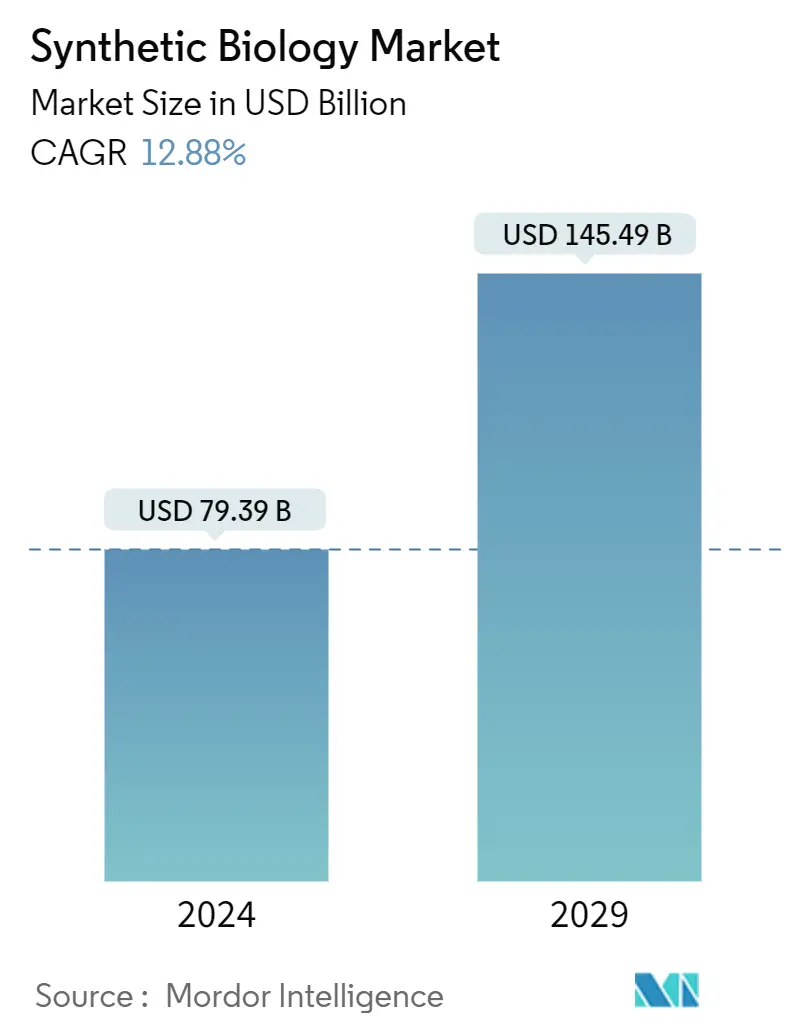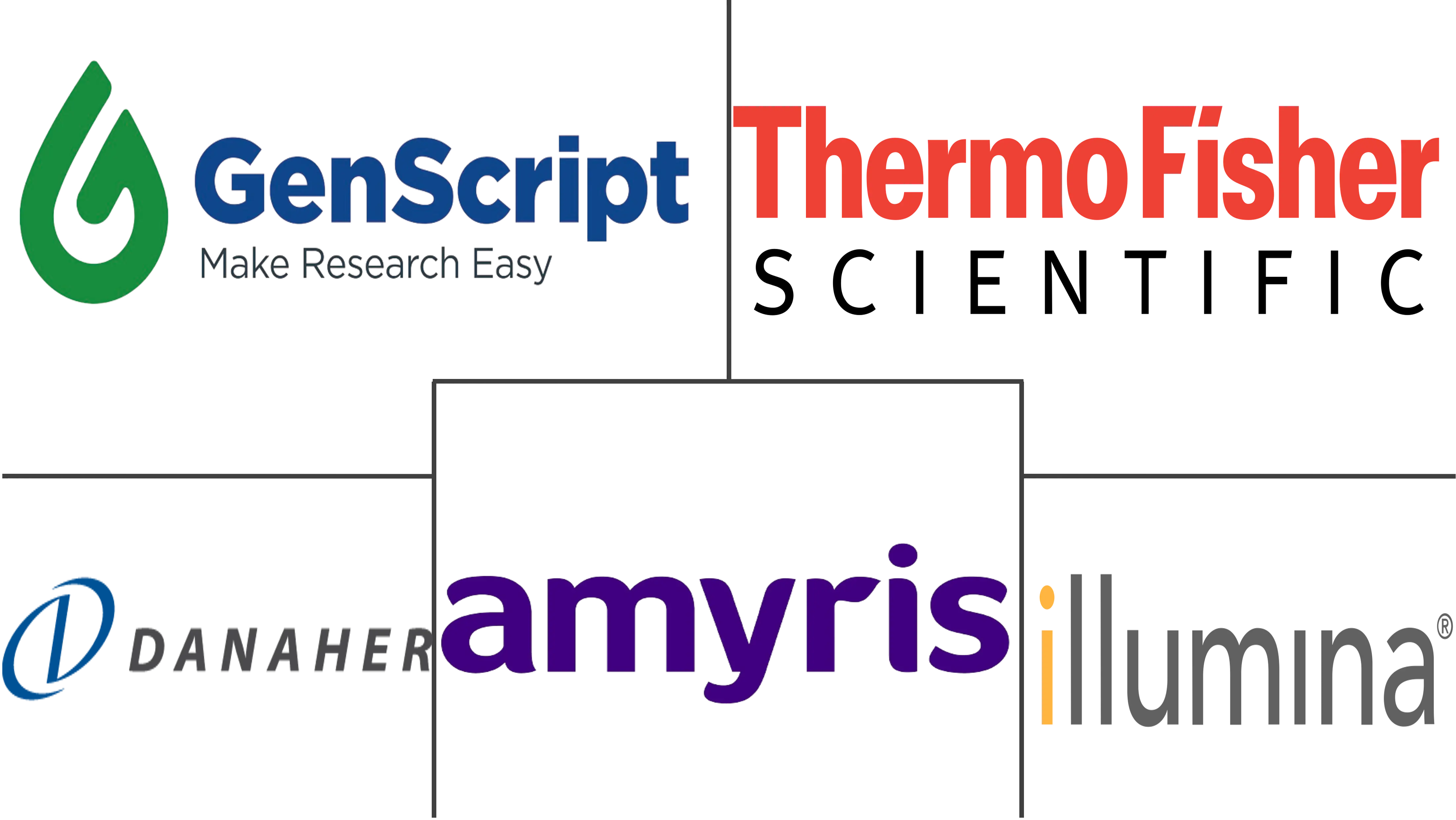Market Size of Synthetic Biology Industry

| Study Period | 2019 - 2029 |
| Market Size (2024) | USD 79.39 Billion |
| Market Size (2029) | USD 145.49 Billion |
| CAGR (2024 - 2029) | 12.88 % |
| Fastest Growing Market | Asia Pacific |
| Largest Market | North America |
Major Players
*Disclaimer: Major Players sorted in no particular order |
Synthetic Biology Market Analysis
The Synthetic Biology Market size is estimated at USD 79.39 billion in 2024, and is expected to reach USD 145.49 billion by 2029, growing at a CAGR of 12.88% during the forecast period (2024-2029).
The market is expected to grow with the increasing support from the government and private institutions, increasing R&D investments in drug discovery, and the development and declining cost of DNA sequencing and synthesizing. The growing involvement of government bodies, research institutes, and large organizations in synthetic biology research activities will likely support the market in the next few years. Governments of various nations have been providing research support for synthetic biology because of its extensive applications. For instance, in September 2022, the Government of New South Wales announced an investment of over USD 6.0 million into a new synthetic biology and biomanufacturing development program, which would improve access to manufacturing and production facilities and equipment across the State of Wales, Australia.
Similarly, many research studies and projects concerning synthetic biology have been running in various countries that have tried to tap multiple complexities in the genomes of organisms, which has helped create more effective and efficient therapies to treat them. For instance, in the United States, SynBio research funding increased from USD 161.0 million in 2022, with public funding totaling USD 820.0 million over the last five years for synthetic biology research. Similarly, the White House of the United States issued an executive order in September 2022, launching a national biotechnology and biomanufacturing initiative that placed synthetic biology as a centerpiece of the strategies for sustainability, competitiveness, and economic growth across all levels of government. The order’s impact could be far-reaching, including significant investments in developing medicines and commodities, reducing waste, and advancing sustainable farming while mitigating climate change impacts.
Synthetic biology technologies and products are also significantly used in various application areas. Since the organisms engineered with synthetic biology techniques are relatively reasonable, owing to their use in various industrial applications, which also translates into a reduction in the cost of research, the demand for these techniques is growing worldwide. Therefore, owing to the aforementioned factors, such as increasing investment in research related to synthetic biology, the market is anticipated to witness growth during the forecast period.
However, factors such as biosafety and biosecurity, ethical issues, and reimbursement cuts, which cause pricing pressure, will likely impede market growth.
Synthetic Biology Industry Segmentation
As per the scope of the report, synthetic biology is a new interdisciplinary area that involves the application of engineering principles to biology. It aims to re-design and fabricate biological components and systems. Therefore, it combines the knowledge of genomics and the chemical synthesis of DNA to produce cataloged DNA sequences rapidly. The synthetic biology market is segmented by product, application, and geography. By product, the market is segmented into core, enabling, and enabled products. By application, the market is segmented into healthcare, chemicals (including biofuels), food and agriculture, and other applications (biosecurity, energy, and environment). By geography, the market is segmented into North America, Europe, Asia-Pacific, the Middle East and Africa, and South America. The report also covers the estimated market sizes and trends for 17 countries across major regions globally. The report offers the value (in USD) for the above segments.
| By Product | |
| Core Products | |
| Enabling Products | |
| Enabled Products |
| By Applications | |
| Healthcare | |
| Chemicals (Including Biofuels) | |
| Food and Agriculture | |
| Other Applications (Biosecurity, Energy, and Environment) |
| Geography | ||||||||
| ||||||||
| ||||||||
| ||||||||
| ||||||||
|
Synthetic Biology Market Size Summary
The synthetic biology market is poised for substantial growth, driven by increasing governmental and private sector support, alongside rising investments in research and development. This growth is further bolstered by advancements in DNA sequencing and synthesizing technologies, which are becoming more cost-effective. The involvement of government bodies, research institutions, and large organizations in synthetic biology research is expected to enhance market dynamics. Notable initiatives, such as the investment by the Government of New South Wales in Australia and the United States' national biotechnology and biomanufacturing initiative, underscore the global commitment to advancing synthetic biology. These efforts are aimed at leveraging synthetic biology for diverse applications, including drug discovery, sustainable farming, and climate change mitigation, thereby fostering a conducive environment for market expansion.
The healthcare sector is anticipated to experience significant growth within the synthetic biology market, driven by its applications in drug and vaccine development, as well as diagnostic tests. The rapid development of synthetic biology technologies has enabled innovative therapeutic approaches, such as the design and manufacture of antigens and variants. Government and organizational support, exemplified by funding initiatives in the United Kingdom and the United States, is expected to further propel market growth. North America, in particular, is set to witness robust expansion due to increased demand for bio-based products and substantial investments in synthetic biology research. The market landscape is moderately consolidated, with key players like Genscript, Thermo Fisher Scientific Inc., and Illumina Inc. leading the charge. Collaborative efforts, such as the establishment of the Rice Synthetic Biology Institute, aim to translate research into societal benefits, reinforcing the market's growth trajectory.
Synthetic Biology Market Size - Table of Contents
-
1. MARKET DYNAMICS
-
1.1 Market Overview
-
1.2 Market Drivers
-
1.2.1 Increasing Support from Government and Private Institutions
-
1.2.2 Increasing R&D Investments in Drug Discovery and Development
-
1.2.3 Declining Cost of DNA Sequencing and Synthesizing
-
-
1.3 Market Restraints
-
1.3.1 Bio-safety and Bio-security
-
1.3.2 Ethical Issues Related to Synthetic Biology
-
1.3.3 Reimbursement Cuts Causing Pricing Pressure
-
-
1.4 Porter's Five Forces Analysis
-
1.4.1 Threat of New Entrants
-
1.4.2 Bargaining Power of Buyers/Consumers
-
1.4.3 Bargaining Power of Suppliers
-
1.4.4 Threat of Substitute Products
-
1.4.5 Intensity of Competitive Rivalry
-
-
-
2. MARKET SEGMENTATION (Market Size by Value - USD)
-
2.1 By Product
-
2.1.1 Core Products
-
2.1.2 Enabling Products
-
2.1.3 Enabled Products
-
-
2.2 By Applications
-
2.2.1 Healthcare
-
2.2.2 Chemicals (Including Biofuels)
-
2.2.3 Food and Agriculture
-
2.2.4 Other Applications (Biosecurity, Energy, and Environment)
-
-
2.3 Geography
-
2.3.1 North America
-
2.3.1.1 United States
-
2.3.1.2 Canada
-
2.3.1.3 Mexico
-
-
2.3.2 Europe
-
2.3.2.1 Germany
-
2.3.2.2 United Kingdom
-
2.3.2.3 France
-
2.3.2.4 Italy
-
2.3.2.5 Spain
-
2.3.2.6 Rest of Europe
-
-
2.3.3 Asia-Pacific
-
2.3.3.1 China
-
2.3.3.2 Japan
-
2.3.3.3 India
-
2.3.3.4 Australia
-
2.3.3.5 South Korea
-
2.3.3.6 Rest of Asia-Pacific
-
-
2.3.4 Middle East and Africa
-
2.3.4.1 GCC
-
2.3.4.2 South Africa
-
2.3.4.3 Rest of Middle East and Africa
-
-
2.3.5 South America
-
2.3.5.1 Brazil
-
2.3.5.2 Argentina
-
2.3.5.3 Rest of South America
-
-
-
Synthetic Biology Market Size FAQs
How big is the Synthetic Biology Market?
The Synthetic Biology Market size is expected to reach USD 79.39 billion in 2024 and grow at a CAGR of 12.88% to reach USD 145.49 billion by 2029.
What is the current Synthetic Biology Market size?
In 2024, the Synthetic Biology Market size is expected to reach USD 79.39 billion.

